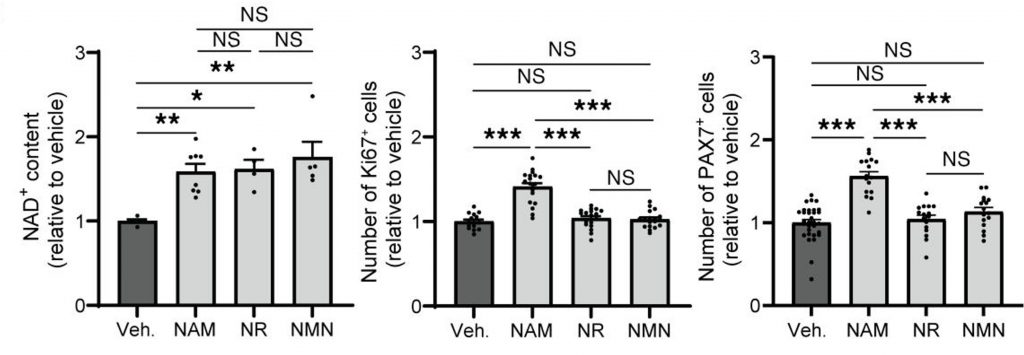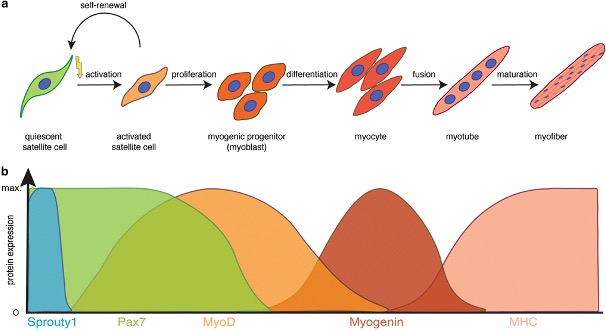Key Points:
- Nicotinamide and vitamin B6 work synergistically to activate muscle stem cells.
- Higher levels of nicotinamide and vitamin B6 are associated with increased muscle mass and strength.
- Nicotinamide combined with vitamin B6 improves muscle stem cell activation in response to exercise.
Aside from allowing us to move voluntarily, our muscles largely determine our basal metabolic rate—the number of calories we burn at rest. In other words, the larger our muscles, the more calories we can consume per day without gaining fat. Importantly, we cannot gain muscle without functioning stem cells. Muscle stem cells drive muscle tissue repair and regeneration, contributing directly to hypertrophy and muscle maintenance.
With age, our muscles gradually lose their ability to regenerate, and most individuals see decrements in mass and strength. Contributing to this age-related muscle atrophy are dysfunctional muscle stem cells, which lose their capacity to regenerate muscle tissue. Now, European researchers have found that nicotinamide and pyridoxine activate muscle stem cells to potentially counteract age-related muscle atrophy.
Synergistic Activation of Muscle Stem Cells
Considering the critical importance of muscle stem cells in maintaining muscle mass, the European researchers, namely Ancel and colleagues, searched for compounds that modulate muscle stem cell function. They screened over 50,000 natural bioactive molecules and plant extracts on muscle stem cells from human donors. Refining their search to FDA-approved molecules, the researchers identified nicotinamide (NAM) and pyridoxine (PN) as the most potent muscle stem cell activators.

NAM, which is a form of vitamin B3, and PN, synonymous with vitamin B6, were shown to play complementary roles in muscle stem cell function. While NAM increased the proliferation of activated stem cells, PN increased their differentiation, all while maintaining self-renewal. What’s more, the effect of combining NAM and PN on muscle stem cell activation was not additive, but synergistic, meaning that the combination produced a greater effect than the sum of each compound’s effect alone.
Nicotinamide: More than an NAD+ Booster
As an NAD+ (nicotinamide adenine dinucleotide) precursor, NAM is known to elevate cellular NAD+ levels. However, Ancel and colleagues suspected that NAM may increase the proliferation of muscle stem cells through other mechanisms. To test this, they compared the effects of NAM to two of the most highly marketed NAD+ precursors, NR (nicotinamide riboside) and NMN (nicotinamide mononucleotide). Interestingly, while all three precursors elevated NAD+ levels in human muscle stem cells, only NAM was shown to increase proliferation. Ultimately, the researchers found that NAM acts on a key cellular pathway (Wnt signaling pathway) involved in stem cell function.

Notably, Princeton and Cornell University researchers have shown that oral ingestion of both NMN and NR is converted to NAM before entering circulation. Additionally, a team in Japan showed that NMN and NR are converted to NAM and then niacin by the gut microbiota before reaching the bloodstream. As such, Ancel and colleagues speculated that the conversion of NMN and NR to NAM reduces the potency of NAM in muscle. Together, these findings suggest that NAM is the preferred NAD+ precursor for activating muscle stem cells.
Of Mice and Men
Moving on from cells in a dish, Ancel and colleagues administered NAM/PN to mice. Eccentric exercise, a component of resistance training, whereby the muscle contracts while lengthened, triggers microtears in muscle fibers. Microtear damage is a key factor in inducing muscle regeneration and growth in response to resistance training (i.e., weightlifting and calisthenics). Using electrical stimulation, the researchers induced eccentric contractions in the mice, acting as a model for resistance training. Not only did NAM/PN increase muscle stem cell activation, but the combo also increased muscle strength by 27%.
Continuing their elucidation of NAM/PN’s effects, the researchers found that muscle NAM and PN concentrations decline during aging in mice. The bioactive form of PN, PLP (pyridoxal-5′-phosphate), also declined with age. NAM/PN supplementation not only restored NAM, PN, and PLP levels in aged mice but also restored muscle stem cell activation. Remarkably, similar effects were observed in older males. In these males, low NAM and PLP levels were associated with less muscle mass and slower gait speed. Furthermore, treating muscle stem cells from older and younger male donors with NAM/PN led to an increase in muscle stem cell activation.

Latest Human Trial Results
Based on the findings of Ancel and colleagues, Højfeldt and colleagues conducted a randomized clinical trial, the gold standard for scientific studies. The trial consisted of 43 male participants between the ages of 18 and 50 who were randomly assigned to either NAM/PN (NAM: 714 mg/day, PN: 19 mg/day) or a placebo for nine days. Similar to the mouse experiment done by Ancel and colleagues, muscle regeneration was induced by electrical stimulation. Specifically, neuromuscular electrical stimulation (NMES) was used to excite the neurons that cause the muscles to contract. NMES electrodes were placed on the outer thigh (vastus lateralis) muscles.
The muscle damage caused by NMES was highly variable, ranging from 0 to ~60% of the muscle fibers analyzed. About a quarter of the participants showed very low or no signs of muscle damage. These participants did not show a regenerative response, as measured by markers of stem cell function, MyoD and Myogenin, which, like PAX7, are transcription factors that activate many genes. Thus, the participants who did not incur significant muscle damage were removed from subsequent analyses.

Supplementation with NAM/PN was shown to increase the number of activated stem cells by 37%, assessed by PAX7. NAM/PN was also shown to enhance the differentiation process by increasing MyoD by 67% and Myogenin by 34%. Furthermore, NAM/PN increased the regeneration of muscle fibers, suggesting that the vitamin B combo accelerates muscle repair.
Enhancing Muscle Regeneration to Counter Sarcopenia
The findings of Ancel and colleagues and Højfeldt and colleagues suggest that taking NAM/PN could counteract sarcopenia—the age-related decline in muscle strength, mass, and quality. This is because one of the factors contributing to sarcopenia appears to be dysfunctional muscle stem cells, whereby the stem cells do not efficiently activate in response to damage. The findings of Højfeldt and colleagues further suggest that NAM/PN’s effects on muscle regeneration may only occur when muscle fibers are sufficiently damaged. In the real world, this could mean that NAM/PN supplementation may only enhance muscle stem cell activations if resistance exercise is performed at an appropriate intensity. Further studies are needed to confirm this notion.